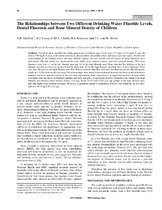| dc.contributor.author | Grobler, Sias Renier | |
| dc.contributor.author | Louw, Adrian | |
| dc.contributor.author | Chikte, Usuf | |
| dc.contributor.author | Rossouw, Roelof | |
| dc.contributor.author | van Wyk Kotze, Theuns | |
| dc.date.accessioned | 2012-08-24T13:59:10Z | |
| dc.date.available | 2012-08-24T13:59:10Z | |
| dc.date.issued | 2009 | |
| dc.identifier.citation | Grobler, S.R.; Louw, A.J.; Chikte, U.M.E.; Rossouw R.J. & Kotze, T.J. (2009).The relationships between two different drinking water fluoride levels,dental fluorosis and bone mineral density of children. The Open Dentistry Journal, 3:48-54 | en_US |
| dc.identifier.issn | 1874-2106 | |
| dc.identifier.uri | http://hdl.handle.net/10566/404 | |
| dc.description.abstract | This field study included the whole population of children aged 10–15 years (77 from a 0.19 mg/L F area; 89
from a 3.00 mg/L F area), with similar nutritional, dietary habits and similar ethnic and socioeconomic status. The fluoride
concentration in the drinking water, the bone mineral content, the bone density and the degree of dental fluorosis were
determined. The left radius was measured for bone width, bone mineral content, and bone mineral density. The mean
fluorosis score was 1.3 in the low fluoride area and 3,6 in the high fluoride area. More than half the children in the low
fluoride area had no fluorosis (scores 0 and 1) while only 5% in the high fluoride area had none. Severe fluorosis (30%)
was only observed in the high fluoride area. The Wilcoxon Rank Sum Test indicated that fluorosis levels differed significantly
(p < 0.05) between the two areas. No relationships were found between dental fluorosis and bone width or between
fluorosis and bone mineral density in the two areas (Spearment Rank correlations). A significant increase in bone width
was found with age but no differences amongst and boys and girls. A significant positive correlation was found in the high
fluoride area between bone mineral density over age. In the 12-13 and 13-14 year age groups in the high fluoride area,
girls had higher bone mineral densities. However, a significant negative correlation (p<0.02) was found for the low fluoride
area (0.19 mg/L F) over age. | en_US |
| dc.language.iso | en | en_US |
| dc.publisher | Bentham Science Publishers | en_US |
| dc.rights | © 2009 Grobler et al; licensee Bentham Open Journals. This is an Open Access article distributed under the terms of the Creative Commons Attribution License (http://creativecommons.org/licenses/by-nc/3.0/), which permits unrestricted use, distribution, and reproduction in any medium, provided the original work is properly cited. | |
| dc.source.uri | http://dx.doi.org/10.2174/1874210600903010048 | |
| dc.subject | Drinking water | en_US |
| dc.subject | Dental fluorosis | en_US |
| dc.subject | Fluoride level | |
| dc.subject | Bone density | |
| dc.subject | Bone mineral content | |
| dc.title | The relationships between two different drinking water fluoride levels, dental fluorosis and bone mineral density of children | en_US |
| dc.type | Article | en_US |
| dc.privacy.showsubmitter | true | |
| dc.status.ispeerreviewed | true | |

